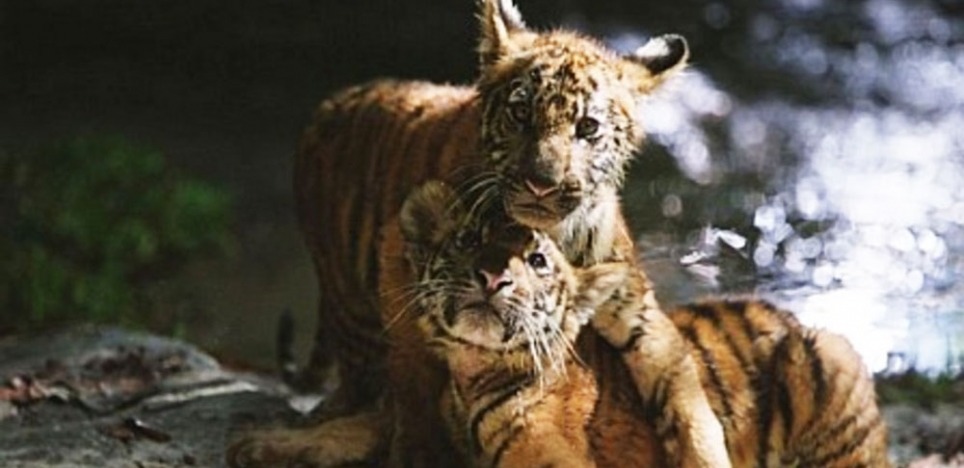Folk tales and teaching stories about animals prove that there are lessons in animal antics, morals in their social structures, and virtues evident in their behavior. That was certainly the case in Jean-Jacques Annaud's 1989 film The Bear, one of our all-time favorite movies. Now he returns to the genre he practically invented — using real animals acting as they would in the wild — to create a film about the importance of respecting animals for their beauty, intelligence, and mystery. It has the tone and feel of a children's fable replete with two adorable tiger cubs, a noble father, a courageous and caring mother, a famous hunter, a prince, some cruel men in a circus, a animal-loving boy, and his parents.
The questions and exercises in this Values & Visions Guide address some of the film's major themes including the nature of tigers, learning from wild animals, the emotions of animals, human domination of animals, mental poisons, the souls of animals, and caring and compassion for animals. The film runs 108 minutes and is rated PG. For our review and a plot synopsis, click here.
1. The Nature of Tigers
"The tiger is the lion of Asia, an enormous, staggeringly beautiful, powerful, and lethal animal — the Eastern king of beasts, at the very top of the food chain. Bold and graphic in appearance, startling in William Blake's memorable phrase 'fearful symmetry,' the tiger is so perfectly camouflaged in the dark and dappled jungle light that it can evoke apprehensive trembling over lurking, shadowed, sudden death. . . . At home in the jungles of India, the mountains of Tibet, or the taiga of Siberia, tigers require only water, shelter and an adequate supply of large prey. . . . Males do not involve themselves with raising cubs; the female, which is considered one of the most dangerous animals in the world when protecting her young, does that. Despite her zealous guardianship, however, only one out of three cubs will survive to maturity. . . . From a psychological point of view, the tiger usually represents dangerous, destructive, and deeply negative emotions, such as overwhelming rage and violence. Yet in myths and folktales, one often finds that a child can safely walk among tigers or lions or snakes. Symbolically this image suggests that neither intellect or power but rather innocence and spontaneity, can deal with such emotions." This description and analysis of the symbolic importance of tigers appears in Elizabeth Caspari's Animal Life in Nature, Myth and Dreams.
- Share your knowledge and/or experiences with tigers in the wild, zoos, folktales, or stories. Read William Blake's poem "The Tyger." Are your /uploads/features/images of tigers positive, negative, or neutral?
- What new information has the film given you about tigers? What emotions did you experience while you were watching the tiger family's life before the humans came?
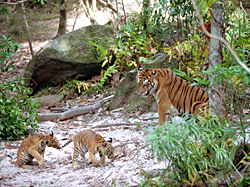
2. Learning from Wild Animals
"I don't think I can learn from a wild animal how to live in particular — shall I suck warm blood, hold my tail high . . . but I might learn something of mindlessness, something of the purity of living in the physical senses and the dignity of living without bias or motive," nature writer Annie Dillard has observed.
- What are your favorite scenes of Kumal and Sangha's life in the jungle with their mother? What can you learn about enjoyment of life from them? Some people, when asked what upsets them about animals in the wild, cite their unpredictability and mystery. Do these qualities bother you or do you find them appealing?
- Have you ever had a close encounter with a wild animal in the wilderness. Share the story and what it meant to you. Then talk about how you felt when you saw Kumal in a cage at the circus. What is your opinion of zoo animals?
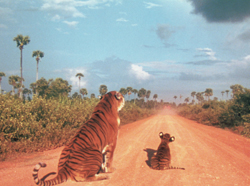
3. The Emotions of Animals
In Talking on the Water, edited by Jonathan White, Richard Nelson states: "Animals have a range of emotion and distinct personalities. They communicate among themselves and they understand human behavior and language. Animals are constantly aware of what people say and do and their presiding spirits are easily offended by disrespectful behavior."
- What has this up-close and personal portrait of tigers taught you about their range of emotion and distinct personalities? What scenes illustrate Kumal and Sangha's understanding of human behavior and language? Which scenes reveal that the tigers are offended by those who treat them badly?
- What observations and/or encounters with wild animals have given you an appreciation for their range of emotion and their distinct personalities? Talk more about this topic in reference to your pets or the pets of friends and relatives.
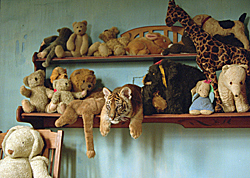
4. Human Attempts to Dominate Animals
In The Ten Trusts, Jane Goodall writes about the human propensity to try and control animals: "Our domination of other animals is all but absolute. Not only can we kill them in the wild and destroy their homes, but we can also exert control over even the greatest of them. We know how to use pain to subdue and control. There are bulls, pigs, and camels with rings through their noses. There are cattle prods to send cruel stabs of pain through rebellious bodies. There are capture guns to anesthetize. There are whips and spurs to strike and goad. And, as a last resort, guns that kill."
- What is it in human nature that compels us to mistreat, harm, and even derive satisfaction from torturing animals? What scenes got you most angry over the mistreatment of Kumal and Sangha?
- In the Korean film Spring, Summer, Fall, Winter . . . and Spring, an old monk discovers that a child monk has tortured animals — tying stones to a fish, a frog, and a snake, then laughing as his victims struggle to get away. That night, the old monk ties a huge stone to the boy's back. He tells him to find the animals, release them, and remember that if any of them is dead, he will carry the burden for the rest of his life. Who taught you to respect animals? What specific lessons did you learn about animals as a child?
5. Mental Poisons
In The Voice of the Infinite in the Small, Joanne Elizabeth Lauck writes: "J. Allen Boone believes that when we are taught to despise a creature, our feelings are a kind of mental poison that is somehow communicated to the creature, which then reacts against it."
- In the tribal village where Aidan McRory, the hunter, takes Kumal, the chief has very negative feelings about tigers, regarding them as threats to both livestock and people (his son lost a leg from a tiger attack). Kumal's owners at the circus also have very toxic attitudes toward the animals they use to make money. In the story, how do the tigers respond to the mental poisons directed at them?
- Have you ever known an animal to react negatively to someone who obviously dislikes it? How do you explain this behavior?
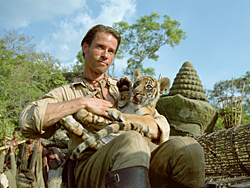
6. Souls of Animals
In The Boundless Circle, Michael W. Fox states: "The more we come to know the unique individual personalities of animals and look into their eyes, the mirror of their souls, the less doubt we will have that there is spiritual quality in all life. In 'The Unexpected Universe.' Loren Eiseley wrote: 'One does not meet oneself until one catches the reflection from an eye other than human.' "
- What scene in the film best conveys the bonding that takes place between McRory and Kumal? What is your favorite scene about the deep relationship between young Raoul and Sangha?
- Talk about your response to Michael W Fox's contention that animals have souls and a spiritual side. What is your belief about animal souls? Continue your discussion by considering the implications of Eiseley's comment that we can't really know ourselves until we have seen ourselves through the reactions of an animal.
7. Compassion and Caring for Animals
"We are beginning to learn that each animal has a life and a place and a role in this world. If we place compassion and care in the middle of all our dealings with the animal world and honor and respect their lives, our attitudes will change. All lives become sacred and we become more careful with our care of them," Marc Befoff writes in The Ten Trusts by Jane Goodall..
- How do you account for McRory's transformation that leads him to forswear hunting? React to the scene where Raoul says goodbye to Sangha?
- In what ways has seeing this film changed some of your ideas, feelings, or attitudes about animals? How would you sum up the the life, the place, and the role of the Kumals and Sanghas in our world today? Identify national organizations and local groups that are working to protect wild animals and their habitats and find a way that you can participate.
A Short Blessing for the Animals
May all my sacred
brothers and sisters
Walk,
Fly,
Swim, and
Move
in Love, Peace, and Freedom.
— from Peace to All Beings by Judy Carman
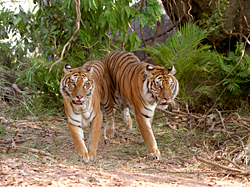
This guide is one in a series of more than 200 Values & Visions Guides written by Frederic and Mary Ann Brussat. Text copyright 2004 by Frederic and Mary Ann Brussat. Photos courtesy of Universal Pictures. This guide is posted as a service to visitors to www.SpiritualityandPractice.com. It may not be photocopied, reprinted, or distributed electronically without permission from Frederic and Mary Ann Brussat. For this permission and for a list of other guides in the Values & Visions series and ordering information, email your name and mailing address to: brussat@spiritualrx.com.
